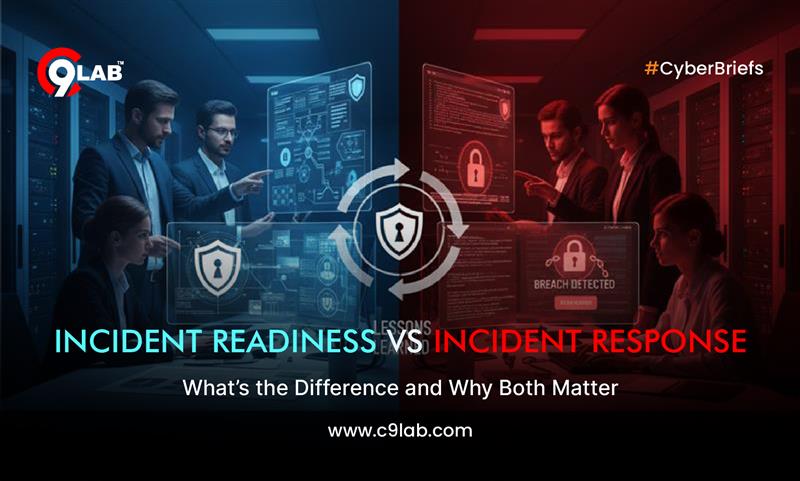Introduction to Digital Risk Score
In an age where nearly everything we do is online—from client communications to financial transactions—cybersecurity is no longer a luxury; it’s a necessity. Yet, many businesses, especially small and mid-sized ones, struggle to keep up with growing threats.
One way to assess your business’s digital security is through something called a Digital Risk Score. Much like a credit score gives you insights into your financial health, a Digital Risk Score gives you a numerical indication of your online security status. And just like financial scores, the higher your digital risk score, the more vulnerable you are to cyber threats.
In this post, we’ll explore what a Digital Risk Score is, why it matters, and dive deeper into the five key pillars of your risk score. We’ll also introduce Business Risk Score (BRS) by C9Lab—a free, easy-to-use tool that helps businesses assess their cybersecurity health.

What is a Digital Risk Score?
A Digital Risk Score acts as a “report card” for your online security posture. It’s a metric that analyzes various elements of your business’s digital presence and assigns a score to indicate how vulnerable you are to cyberattacks. The score reflects your exposure across multiple fronts such as email security, website protection, and dark web threats. Think of it as a snapshot of your business’s overall cybersecurity health.
Much like a credit score, the higher your Digital Risk Score, the more vulnerable you are. The goal is to keep this score as low as possible by addressing vulnerabilities and improving your overall security.
Why Does Your Digital Risk Score Matter?
The risks associated with poor cybersecurity are real and significant:
- 60% of small businesses shut down within 6 months of a cyberattack (NCSA).
- The average cost of a data breach hit $4.45 million in 2023 (IBM).
- 43% of cyberattacks target small businesses, but only 14% are prepared to defend themselves (Accenture).
- Email-based attacks such as phishing and business email compromise remain the #1 attack vector for most breaches.
Cybercriminals often target low-hanging fruit—small businesses that haven’t implemented strong digital defenses. A Digital Risk Score gives you visibility into your weak spots, so you can address them proactively and reduce your exposure.
How is a Digital Risk Score Calculated?
Your Digital Risk Score is calculated using various signals and metrics gathered from your digital footprint. Each of these factors contributes to your overall score. These include:
- IP Address and Device Reputation: Are your devices or IP addresses flagged for suspicious activity?
- Behavioral Analytics: Do your login patterns match typical human behavior, or do they raise red flags?
- Email and Domain Verification: Do you use proper email security protocols like SPF, DKIM, and DMARC?
- Dark Web Exposure: Have your credentials been leaked or exposed on the dark web?
- Infrastructure Vulnerabilities: Are your website, servers, and databases properly secured?
The more risk signals the system picks up, the higher your score and the greater your vulnerability to cyberattacks.
The 5 Key Pillars BRS Analyzes
Now, let’s break down the five critical pillars that the Business Risk Score (BRS) evaluates to determine your overall risk:
1. Website Performanc

What It Is:
Website performance refers to how quickly and reliably your website loads for users. BRS assesses the speed, responsiveness, and overall user experience of your site.
Why It Matters:
Website performance isn’t just a matter of convenience—it impacts user trust and security. A slow or unreliable website can drive customers away, harming your reputation. Additionally, poor performance could be a sign of vulnerabilities that hackers can exploit, such as susceptibility to Denial of Service (DoS) attacks, where attackers flood your website with traffic to make it unavailable.
A fast, well-performing website ensures a positive user experience and reduces the chances of malicious actors exploiting performance-related weaknesses.
A fast, well-performing website ensures a positive user experience and reduces the chances of malicious actors exploiting performance-related weaknesses.
2. External Website Security

What It Is:
This pillar focuses on the security measures your website employs to protect against external attacks. BRS evaluates the strength of critical security elements such as SSL certificates, HTTP headers, and HTTP Strict Transport Security (HSTS).
Why It Matters:
- SSL Certificates: SSL (Secure Sockets Layer) encryption ensures that data transferred between your site and visitors is encrypted. Without SSL, attackers can intercept sensitive information like login credentials or credit card numbers.
- HTTP Headers: These help secure your website by controlling how browsers interact with your site. Proper headers can prevent certain types of attacks like clickjacking or cross-site scripting (XSS).
- HSTS: This security feature forces browsers to communicate with your website using HTTPS, ensuring data is always encrypted. Without HSTS, attackers could downgrade your secure connection to an insecure one.
Weak external security could leave your website exposed to cybercriminals looking for easy targets. By strengthening these areas, you significantly reduce your risk of attack.
3. Email Security

What It Is:
Email security ensures that your communications remain safe from threats like phishing, spoofing, and business email compromise. BRS checks whether critical email authentication protocols such as SPF (Sender Policy Framework), DKIM (DomainKeys Identified Mail), and DMARC (Domain-based Message Authentication, Reporting & Conformance) are correctly configured.
Why It Matters:
- SPF: Verifies that the email sender is authorized by the domain’s administrator.
- DKIM: Adds a digital signature to outgoing emails, making it harder for attackers to impersonate your domain.
- DMARC: Combines SPF and DKIM to ensure that email messages are properly authenticated and aligned with the sender’s domain.
Without these protections, your business is highly vulnerable to phishing attacks and email fraud. Implementing email security protocols drastically reduces the risk of your
4. Domain Protection

What It Is:
Domain protection involves securing your DNS setup and WHOIS data to prevent unauthorized access and domain spoofing. BRS analyzes whether your domain configuration is at risk of being hijacked or misused by attackers.
Why It Matters:
- DNS Setup: A compromised DNS system can redirect your users to malicious websites that appear legitimate. Securing your DNS helps prevent this risk.
- WHOIS Data: WHOIS contains details about the owner of a domain. Attackers often use this data to target businesses. Ensuring your WHOIS data is private or properly configured reduces the chance of it being used in social engineering attacks.
Domain protection is crucial for preventing attackers from impersonating your business and gaining access to sensitive information.
5. Dark Web Exposure

What It Is:
Dark web exposure refers to whether your company’s data—such as email addresses, passwords, or sensitive business information—has been leaked or found on the dark web. BRS scans known dark web sources to identify whether any of your data is exposed.
Why It Matters:
The dark web is a haven for cybercriminals who trade stolen data. If your email addresses, passwords, or other sensitive business information are found on the dark web, it’s a clear indication that your business is at high risk of future attacks. Early identification allows you to take action, such as changing passwords, monitoring accounts, and preventing further exposure.
Why BRS by C9Lab is a Game-Changer
Business Risk Score (BRS) by C9Lab offers a free, easy-to-use tool that helps businesses of all sizes assess their digital health in just minutes. It analyzes all the crucial aspects of your online presence, providing a clear, actionable score that reflects your business’s cybersecurity posture.
Here’s why BRS is a game-changer for small and mid-sized businesses:
- Free: No need for a big budget to get started.
- Quick and Easy: Just enter your domain, and in minutes, you’ll get your score.
- No Login or Setup: Privacy-first, no sign-up required.
- Actionable Insights: Clear, easy-to-understand recommendations for improving your security.
How to Get Your Business Risk Score (Step-by-Step)
- Visit https://brs.c9lab.com.
- Enter your business domain name.
- Click ‘Check Risk Score’.
- Review your score and the detailed breakdown of your results.
- Take action based on the recommendations provided.
Final Thoughts
Cyberattacks are growing more sophisticated and frequent, and understanding your Digital Risk Score is one of the most proactive steps you can take as a business owner. Tools like BRS by C9Lab make it easy, free, and actionable to assess your digital health and improve your security posture.
Don’t wait for a breach to happen. Know your score. Strengthen your defenses. Protect your business.
Ready to find out where your business stands?
To Stay updated with the latest trends and new in cybersecurity sphere follow our newsletter- Cyber Briefs

















